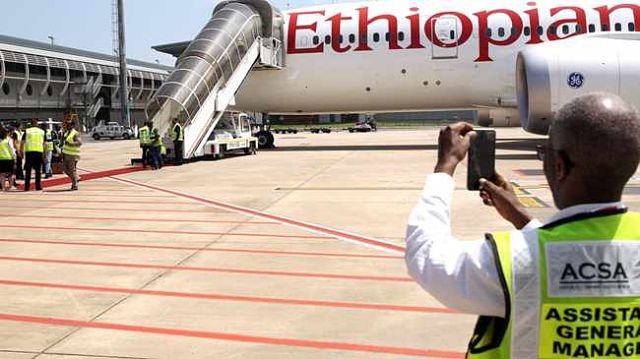 Last week saw Ethiopian Airlines make headlines for all the right reasons: It opened the world’s first contactless airport terminal and the US Congress vindicated the airline concerning the 737-MAX 8 that crashed shortly after takeoff from Addis Ababa on March 10th, 2019 killing all 157 on board. (Photo: ANA)
Last week saw Ethiopian Airlines make headlines for all the right reasons: It opened the world’s first contactless airport terminal and the US Congress vindicated the airline concerning the 737-MAX 8 that crashed shortly after takeoff from Addis Ababa on March 10th, 2019 killing all 157 on board. (Photo: ANA)
Independent Online
Ethiopian Airlines (ET) made another noteworthy headline last week. It opened the world’s first contactless airport terminal, which was completed during the pandemic when airlines were closing operations.
The $300 million (about R5 billion) project is part of Terminal 2 of the bigger Bole International Airport project in Addis Ababa, Ethiopia.
This headline coincided with another historic announcement involving ET. The US Congress vindicated ET in ways nobody imagined, especially Boeing – the American manufacturer of the four-month old 737-MAX 8 jet that crashed on March 10, last year, just outside Addis Ababa.
What made the crash of flight ET 302 spectacular was not only the death of 150 or so passengers and crew, but the arrogance with which Boeing initially handled everything.
Instead of waiting for an investigation, the company dismissively said: “Safety is Boeing’s number one priority and we have full confidence in the safety of the 737 MAX.”
Although the crash was the second involving the 737 MAX 8 in less than five months, the other having been the October 2018 Lion Air Flight 610 in Indonesia, Boeing – a $101billion Fortune 500 company – displayed disdain and insensitivity towards African life, by shirking responsibility.
Now, the US Congress has found that the reason for the crash had nothing to do with the pilot or management of ET. The House Committee on Transportation & Infrastructure says: “The facts laid out in this report document a disturbing pattern of technical miscalculations and troubling management misjudgments made by Boeing. It also illuminates numerous oversight lapses and accountability gaps by the FAA that played a significant role in the … crashes”.
The report commended ET for having “flourished over the past two decades as it has capitalised on a strategy to connect primary and secondary markets across the African continent with North American, European, and Asian destinations”, adding its “pilot training programs and facilities have garnered praise from seasoned American pilots”.
As Boeing prepares to return about 700 of its 737s to the skies in the gradual reopening of international air travel it will do so while eating humble pie. It hopefully has learnt to duly respect ET – one of its major customers.
The bottom line remains that the 737 MAX 8 had a technical fault due to the aircraft design. The design improvement was intended to make the jet travel longer distances and carry more passengers. The new bigger 737 MAX 8 shape shifted the engine of the aircraft forward, without any major redesign of the 737 fuselage – which apparently has not changed in five decades.
—
Related:
Boeing to Stop 737 Max Production (AP)
Internal FAA review saw high risk of 737 MAX crashes
Boeing Was Aware of 737 Max Problem Long Before Ethiopia Crash – Report
Boeing CEO Apologizes to Victims of Ethiopia, Indonesia Crashes
Ethiopian Airlines Slams Bloomberg’s Ex-Pilot Story as ‘Baseless & False Allegation’
Read Excerpt From Ethiopia Crash Report
Ethiopian Airlines Expresses Disappointment – Calls Out Media Outlets Eager to Blame Pilot
Watch: Ethiopian CEO on The Future of Boeing 737 Max Planes — NBC Exclusive
Watch: Ethiopia Releases 737 Max Preliminary Crash Report
Join the conversation on Twitter and Facebook.

























